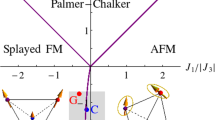It is shown that because of their high magnetic susceptibility δ plutonium and its alloys are close to magnetic instabilities; dynamic effects of short-range magnetic order which are associated with the fluctuating magnetization density of electrons – spin fluctuations – play a large role in them. Long-range ferro- and antiferromagnetic order is suppressed. A model is developed for the spin fluctuations in plutonium. In this model, because of strong magneto-elastic coupling the spin-fluctuation energy depends on the volume of the crystal and is independent of temperature and spatial dispersion. It is shown that the contribution of the zero-point quantum spin-fluctuations is largely temperature-independent, as a result of which saturation of local magnetic moments is absent, the Curie–Weiss law for the magnetic susceptibility breaks down, and below the melting temperature plutonium is a strongly quantum system. An explanation is given for the thermal expansion anomalies of the δ phase of plutonium and its alloys on the basis of the theory of magneto-volume effect with a negative magneto-elastic coupling constant.
Similar content being viewed by others
References
J. Lashley, A. Lawson, R. McQueeney, et al., “Absence of magnetic moments in plutonium,” Phys. Rev. B, 72, 54416 (2005).
V. P. Silin and A. Z. Solontsov, “Contribution to the band theory of antiferromagnetism of metals,” Zh. Eksp. Teor. Fiz., 73, No. 3, 1073–1084 (1977).
L. Nordstrom and D. Smith, “Noncollinear inter-atomic magnetism,” Phys. Rev. Lett., 76, No. 23, 4420–4423 (1996).
A. A. Ivanov, “Magnetic susceptibility of uranium, plutonium, and their alloys with other metals,” Author’s Abstr. of Candidate’s Dissertation in Technical Sciences, VNIINM, Moscow (1959).
V. P. Antropov, M. I. Katsnelson, A. I. Likhtenshtein, et al., “Electronic structure, magnetism, and anomalous lattice properties of different phases of plutonium,” Fiz. Tver. Tela, 32, No. 9, 2782–2790 (1990).
V. I. Anisimov, A. O. Shorkov, and J. Kunes, “Magnetic state and electronic structure of plutonium from first-principles calculations,” in: Condensed Matter (2006), No. 0610829vl.
P. Soderlind and B. Sadigh, “Density-functional calculations of α, β, γ, δ, δ′, and ε plutonium,” Phys. Rev. Lett., 92, No. 18, 185702 (2004).
A. Arko, J. Joyce, L. Morales, et al., “Electronic structure of α- and δ-Pu from photoemission spectroscopy,” Phys. Rev. B, 62, 1773–1779 (2000).
S. Meot-Raymond and J. Fournier, “Localization of 5f electrons in δ-plutonium: evidence for the Kondo effect,” J. Alloys Compounds, 232, 119–125 (1996).
A. Freeman and J. Darby (eds.), The Actinides: Electronic Structure and Related Properties, Academic Press, NY (1974), Vol. II.
P. Erdos and J. Robinson, Actinide Compounds, Plenum Press, NY (1983).
T. Moriya, Spin Fluctuations in Magnets with Collectivized Electrons [Russian translation], Mir, Moscow (1989).
A. Lawson, J. A. Roberts, B. Martinez, et al., “Invar model for the δ-phase Pu: thermal expansion, elastic and magnetic properties,” Phil. Mag., 86, 2713–2733 (2006).
E. Wassermann, “Invars: moment-volume instabilities in transition metals and alloys,” in: Ferromagnetic Materials, edited by K. Buschow and E. Wohlfarth, North Holland, Amsterdam (1991), Vol. 5.
N. Lang and H. Ehrenreich, “Itinerant-electron theory of pressure effects on ferromagnetic transition temperature: Ni and Ni–Cu alloys,” Phys. Rev., 168, No. 2, 605–622 (1968).
A. Z. Solontsov, “Charge-density fluctuations in system with heavy fermions,” Fiz. Tver. Tela, 32, No. 1, 3–9 (1990).
A. Solontsov, “Spin fluctuations and anharmonicity in itinerant electron magnetism,” Intern. J. Mod. Phys. B, 19, No. 24, 3631–3681 (2005).
C. Loong, B. Grier, S. Shapiro, et al., “Neutron scattering studies of the paramagnetic response in the mixed-valence alloy Ce1−x Th x at high energy,” Phys. Rev. B, 35, 3092–3101 (1987).
A. Z. Solontsov and D. Wagner, “Zero-point spin fluctuations and magnetovolume effect in itinerant electron magnetism,” Phys. Rev. B, 51, 12410–12417 (1995).
L. D. Landau, Theoretical Physics, Nauka, Moscow (1976), Vol. 5.
M. Shiga, “Spin fluctuations in itinerant frustrated systems,” in: Itinerant Electron Magnetism: Fluctuation Effects and Critical Phenomena, edited by D. Wagner,W. Brauneck, and A. Solontsov, Kluwer Academic Publisher, Dordrecht (1998), p. 1–14.
Yu. Piskunov, K. Mikhalev, A. Gerashenko, et al., “Spin susceptibility of Ga-stabilized δ-Pu probed by 69Ga NMR,” Phys. Rev. B, 71, 174410 (2005).
Author information
Authors and Affiliations
Additional information
Translated from Atomnaya Énergiya, Vol. 107, No. 4, pp. 214–221, October, 2009.
Rights and permissions
About this article
Cite this article
Solontsov, A.Z., Orlov, V.K., Kiselev, S.A. et al. Magnetism and anomalous properties of plutonium. At Energy 107, 263–271 (2009). https://doi.org/10.1007/s10512-010-9224-0
Received:
Published:
Issue Date:
DOI: https://doi.org/10.1007/s10512-010-9224-0



